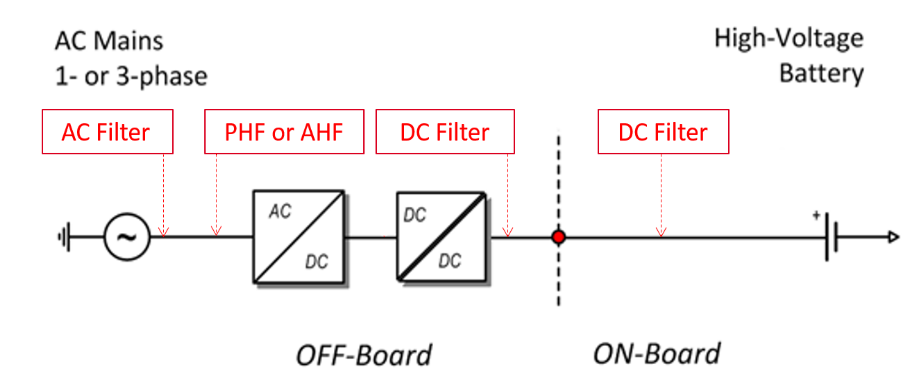Take charge of e-mobility
E-mobility and the supply of the energy required for charging facilities are taking centre stage in automotive electronics, says Holger Urban, Schaffner Group
Current available technologies for renewable energy generation can be used to form a decentralised supply grid. To balance the available power infrastructure, energy storage systems need to be close to the point of load. In order to maintain reliable interoperability between the different partnering systems (e.g. battery charging system for electric vehicles (EVs), battery storage and photovoltaic (PV) installations, EMC/EMI requirements need to be considered carefully, otherwise the expected level of services cannot not guaranteed.
E-mobility practicalities
Research by Accenture indicates that EVs will dominate our roads by 2040, and drivers will generate $2 trillion for utility companies globally as drivers charge their cars. As well as charging at home, there is an expectation to use charging stations as part of a public charging infrastructure, for true e-mobility. As well as introducing and maintaining a comprehensive network of charging points, the report says that utilities can aid and profit from e-mobility with integrated home energy management. Utilities should be able enhance services, for example congestion management to allow them to balance supply and demand for EV charging.
EMC and EV charging
Charging an electric car is not just a matter of simply plugging it in to a home power socket. Batteries are a DC power source, therefore a conversion of power supplied from the AC grid needs to take place at some point. This conversion generates EMC noise all over the system that migrates through cables to the grid or the car or possibly both. Figure 1 illustrates the requirements for filtering components on both sides of a power converter/inverter to limit the disturbances spreading out all over the system.
 Figure 1: Filtering components are required on both sides of a power converter/inverter
Figure 1: Filtering components are required on both sides of a power converter/inverter
In order to meet the EMC requirements of the charging systems, relevant standards must be considered and complied with. IEC 61851 deals with all types of stationary installed charging systems for both residential and industrial environments. Most recently the AC and DC EMC/EMI limits for EV charging applications were defined according to generic standards IEC 61000-6-1 to IEC 61000-6-4.
Standard AC filters (up to 690V AC) or DC Filters (up to 1500V DC) are readily available and custom solutions can be specified if required to meet the requirements of the local charging infrastructure.
These are also modular designs allowing different filter capacitor setups without capacitive coupling between power lines and power entry (no Y-capacitors).
Standard filters can be used for lower power installations, including RFI filtering for charging control systems.
Fast charging installations in shopping centres or for public transport are to charge buses and other vehicles which require high current ratings of 50A or more.
Charging points
For any charging system it needs to be recognised that charging a number of vehicles simultaneously requires very high available energy at the point of load. This can only be provided reliably with a decentralised installation of energy storage systems to balance the supplying grid or to form a grid independent solution (e.g. wind turbine or a PV installation). Such installations need to be tested according to IEC 61851 (stationary systems) and IEC 61000-6-1 to IEC 61000-6-4 for EMC/EMI limits.
Local RFI filtering (ranging from 9kHz to 30MHz) is a prime consideration for EV charging and it may also be necessary to consider the whole range of electromagnetic disturbances, including harmonics mitigation or LCL filtering in lower disturbance bandwidths to ensure system reliability.
LCL filters or power quality solutions are used in different kinds of charging applications, each having their own unique requirements. For bi-directional energy storage, an LCL filter is generally required to allow the system to be safely connected to the supply grid.
For example, the FN6840 three-phase LCL mains filter (Figure 3) targets active front end and active in-feed converters in regenerative systems that feed waste energy back to the grid, machines characterised by frequent braking cycles.
It can limit the ripple current generated by the drive or converter to less than 5% and reduces voltage distortions. It work with 50 or 60Hz and downstream switching in the 3.0 to 10kHz range. Five current ratings are available from 25 to 380A at 480V AC.
Power quality filters are fitted if the system is not using regenerative approach. These filters are used to dampen the harmonics of the 50 or 60Hz supplying grid base frequency.
EMC/EMI requirements require consideration for both approaches and it is essential to select an RFI filter perfectly adjusted to the LCL or power quality filter.
In conclusion, e-mobility without decentralised energy storage is not possible. The relationship between mobility and storage is the future and links known technologies, such as inverters and renewable energy.
Additional reporting: Caroline Hayes







